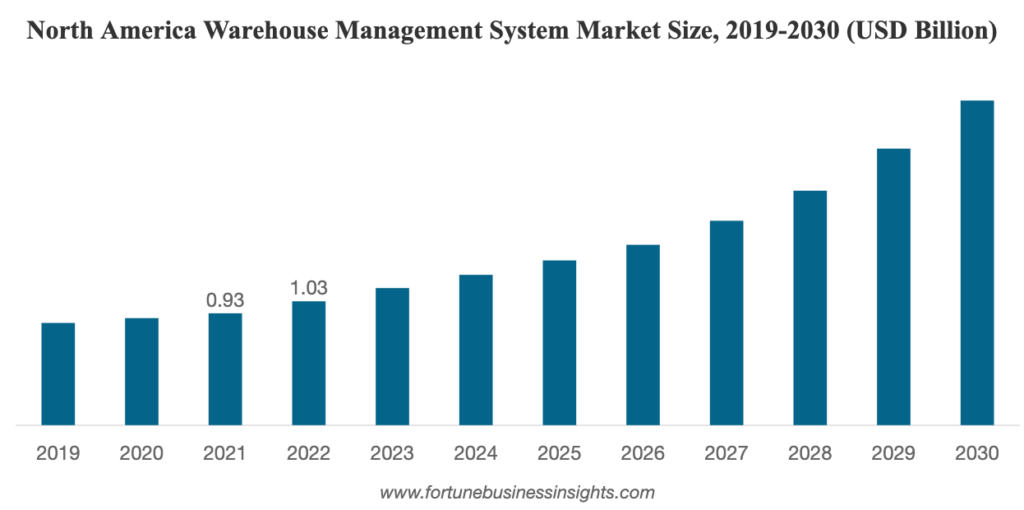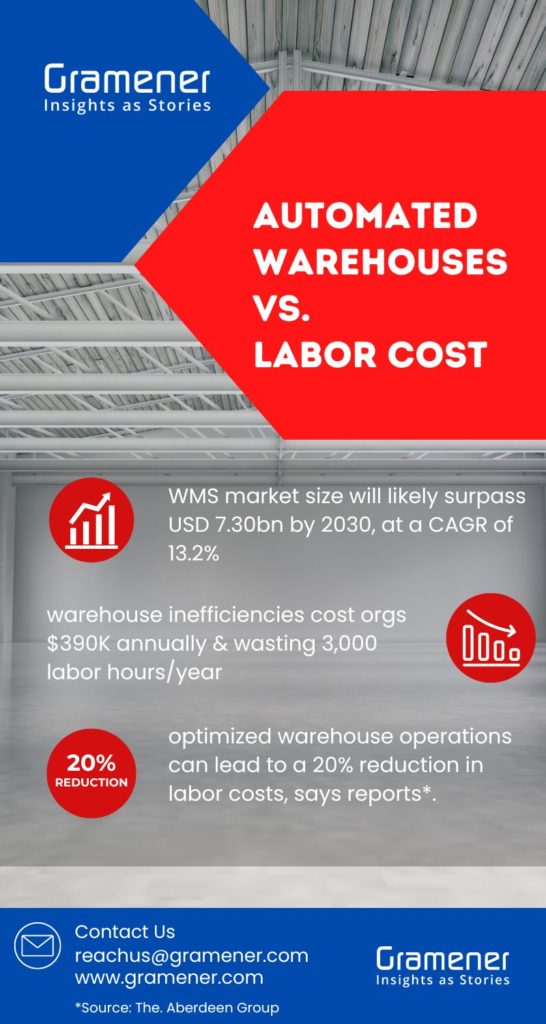Efficient warehouse management has become increasingly vital for organizations aiming to enhance their operational performance. The need for effective warehouse optimization techniques grows as the global market evolves. According to recent research, the Warehouse Management System (WMS) market size will likely surpass USD 7.30 billion by 2030, at a (CAGR) of 13.2%.

Businesses must adopt intelligent strategies to stay ahead of the curve. In this article, we will explore eight efficient warehouse optimization tips with practical advice on how to optimize warehouse operations.
Table of Contents
What is Warehouse Optimization? Why is it Important?
Warehouse optimization involves maximizing the efficiency and productivity of a warehouse facility. It includes implementing strategies and technologies to reduce costs and minimize errors. Studies have shown that inefficient warehouse operations can result in significant financial losses.
According to a survey, warehouse inefficiencies cost companies $390,000 annually. Additionally, inefficient processes can waste 3,000 labor hours in a year. Prioritizing warehouse space management allows businesses to mitigate these risks and achieve substantial cost savings.
A Glimpse of How Gramener Adds Value to Fleets & Warehouse Operations
Benefits of Warehouse Optimization
Warehouse optimization techniques can impact a business’s bottom line and overall success. Let’s explore them in detail.
Increased Employee Efficiency
Implementing optimized workflow, automation, and inventory management systems allows employees to work more efficiently. It leads to reduced human errors and improved productivity. A study by the Aberdeen Group found that optimized warehouse operations can lead to a 20% reduction in labor costs.

Enhancing Organizational Workflow
Warehouse space management enables smoother coordination and collaboration between procurement, inventory management, and shipping. Streamlining these processes minimizes bottlenecks and reduces lead times. According to a study by McKinsey, optimizing warehouse processes can result in reduced lead times.
Preventing Lost Sales Opportunities
Inefficient warehouse operations can result in stockouts, missed deliveries, and delayed order fulfillment. All these factors lead to lost sales opportunities. Optimizing inventory management and order fulfillment processes helps businesses ensure products are available when customers need them.
Cost, Time, and Resource Optimization
Warehouse slotting optimization strategies like space utilization and demand planning can lead to significant cost savings. Optimizing storage space helps businesses reduce warehouse footprint and associated costs. Efficient inventory control prevents overstocking or
stockouts. It reduces carrying costs and improves cash flow. Optimized order fulfillment processes reduce order processing time and minimize labor and transportation costs.
Enhanced Precision in Planning and Forecasting
With accurate and real-time data from optimized warehouse operations, businesses can improve their planning and forecasting capabilities. It enables better inventory management and more accurate demand forecasting.
Read more: Smart Warehouse – Unveiling Benefits, Challenges, and Real-World Use-Cases
8 Warehouse Optimization Techniques
Your business can implement the following strategies to achieve optimal warehouse performance:
Reducing Human Errors
Human errors can lead to costly mistakes and delays. Providing proper training and implementing quality control measures can reduce errors and improve accuracy. Technologies such as barcode scanning and RFID can help with inventory management and order fulfillment.
Implementation of Automated Shipping Routing
Automating the shipping routing process helps streamline transportation operations. Leveraging route optimization software helps businesses determine the most efficient routes. It reduces fuel costs and minimizes delivery times for improved delivery performance.
Warehouse Slotting Optimization
Looking for ideas on how to maximize warehouse space? Analyzing data on product velocity and demand patterns can help businesses optimize their warehouse layout and reduce picking and replenishment times. Proper warehouse slotting ensures products remain in the most logical and efficient locations.
Predicting Demand
Accurate demand forecasting is crucial for efficient inventory management. Utilizing advanced analytics and forecasting models allows businesses to predict demand patterns accurately. They can also reduce stockouts and excess inventory and improve warehouse efficiency.
For instance, Gramener provides solutions to improve warehouse demand forecasting capabilities with ~95% accuracy rate. We use sophisticated algorithms and cutting-edge technologies to achieve impressive accuracy in predicting demand patterns for warehouses.
Load Planning
Efficient load planning plays a vital role in optimizing transportation operations. Analyzing historical data and data analytics tools helps businesses evaluate vehicle and driver performance. They can also maximize load capacity and minimize the risk of accidents.
Gramener offers smart mobility solutions to monitor and assess vehicle and driver performance by analyzing various data points, like driver behavior and vehicle maintenance records, which help identify potential risks and areas for improvement.
Appointment Scheduling
Implementing a predictive appointment scheduler can help improve carrier turn times. Data analytics and machine learning algorithms can optimize the scheduling of appointments and minimize wait times.
Gramener’s predictive appointment scheduler has helped reduce truck turn-around time by 16%. It leverages advanced predictive analytics algorithms to optimize the allocation of resources and efficiently plan truck appointments.
Smart Labor Allocation
Efficiently allocating labor resources is essential for warehouse optimization. Workforce management systems help businesses analyze labor requirements and administer resources effectively. It leads to improved productivity and reduced labor costs.
Using Warehouse Optimization Software
Investing in warehouse optimization software can enhance operational efficiency. These software solutions offer inventory management, order tracking, real-time data analysis, and reporting features. It allows businesses to make data-driven decisions and optimize warehouse operations.
Practical Example and Case Study of Warehouse Optimization
Merchandise Warehouse, a logistics provider specializing in multi-temperature warehouse services, sought to enhance its operations and accommodate growing customer demands. Despite their previous success with traditional warehouse operations, the company recognized the need for improvement as they faced capacity constraints. They decided to implement high-density, deep lane racking and a pallet shuttle system called Radioshuttle, specifically designed for cold storage.
Radioshuttle enabled increased storage capacity and faster product handling while minimizing product damage. Using the warehouse’s full height and high-density racking helped Merchandise Warehouse optimize its storage utilization. The integration of three conveyor systems further improved efficiency.
With the new solutions, Merchandise Warehouse added over 14,000 pallet positions without increasing staffing levels. Overall, the warehouse’s efficiency increased by 44%. Tasks that previously took seven person-hours now got completed in about four. The number of touches required to move products through the warehouse got reduced from 12 to six. The spacer removal process was optimized, reducing the time from four hours to two.
Gramener’s POV on Warehouse Optimization
Warehouse optimization is essential for businesses aiming to improve efficiency and reduce costs. Strategies like reducing implementing automation, optimizing slotting, and predicting demand help organizations unlock their warehouse’s true potential. Leveraging Gramener’s supply chain solutions, which offer improved demand forecasting and data analytics for enhanced warehouse efficiency, can significantly impact operational performance.
Contact us today if you want to optimize your warehouse operations and improve your business’s bottom line. We will help you understand your warehouse optimization needs and discover how Gramener’s expertise can help you achieve your goals.



